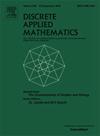边相加和Kemeny常数的变化
IF 1
3区 数学
Q3 MATHEMATICS, APPLIED
引用次数: 0
摘要
给定一个连通图G, Kemeny常数K(G)测量随机行走到达随机选择顶点的平均旅行时间。众所周知,当G中加入一条边时,Kemeny常数的值可能会减小、增大或保持不变。在本文中,我们给出了当初始图是一个有n个顶点的树时这种行为的定量分析。我们证明了当一条边被添加到有n个顶点的树中时,Kemeny常数的最大可能增加大约是23n,而最大可能减少大约是316n2。我们还确定树和要添加的边,对应于最大增加和最大减少。在整个过程中,同时使用了矩阵理论和图论技术。本文章由计算机程序翻译,如有差异,请以英文原文为准。
Edge addition and the change in Kemeny’s constant
Given a connected graph , Kemeny’s constant measures the average travel time for a random walk to reach a randomly selected vertex. It is known that when an edge is added to , the value of Kemeny’s constant may either decrease, increase, or stay the same. In this paper, we present a quantitative analysis of this behaviour when the initial graph is a tree with vertices. We prove that when an edge is added into a tree on vertices, the maximum possible increase in Kemeny’s constant is roughly while the maximum possible decrease is roughly . We also identify the trees, and the edges to be added, that correspond to the maximum increase and maximum decrease. Throughout, both matrix theoretic and graph theoretic techniques are employed.
求助全文
通过发布文献求助,成功后即可免费获取论文全文。
去求助
来源期刊

Discrete Applied Mathematics
数学-应用数学
CiteScore
2.30
自引率
9.10%
发文量
422
审稿时长
4.5 months
期刊介绍:
The aim of Discrete Applied Mathematics is to bring together research papers in different areas of algorithmic and applicable discrete mathematics as well as applications of combinatorial mathematics to informatics and various areas of science and technology. Contributions presented to the journal can be research papers, short notes, surveys, and possibly research problems. The "Communications" section will be devoted to the fastest possible publication of recent research results that are checked and recommended for publication by a member of the Editorial Board. The journal will also publish a limited number of book announcements as well as proceedings of conferences. These proceedings will be fully refereed and adhere to the normal standards of the journal.
Potential authors are advised to view the journal and the open calls-for-papers of special issues before submitting their manuscripts. Only high-quality, original work that is within the scope of the journal or the targeted special issue will be considered.
 求助内容:
求助内容: 应助结果提醒方式:
应助结果提醒方式:


